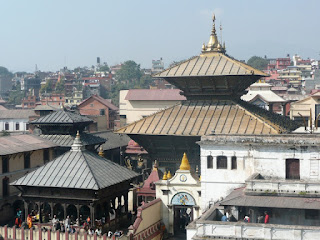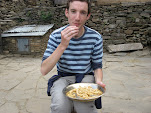We first visited Kathmandu Durbar Square in the middle of Kathmandu. It was a good place to start as it gave a good flavour of Nepal - a manic taxi ride followed by temples, hawkers, living goddesses and tiny streets packed with people and motorbikes. Our first stop was the Kumari Ghar, the house of the living goddess for Kathmandu, who is supposed to represent the God Taleju. She is a pre-pubescent girl selected from a set of highly ritualised conditions. Her view is considered by many Nepalis to be a blessing. After wandering through and looking at the many temples built in the square we moved to the tourist ghetto of Thamel, for a bit of shopping and a look-see.

The next day, Saru joined us for a walk around Patan, starting at Patan Dhoka, the gate where the peoples movement of 1990 held its ground, and moved on to the historic, and patently more pretty than Kathmandu's version, Patan Durbar Square via a number of little temples, hidden in nooks and crannies all along the side streets.

After returning from Pokhara, we had a day of big temple and stupa visits. Auntie Kathy had decided to stay in the hotel, as her leg was a bit sore after the exertions in the the mountains. So we visited Pashupathinath, Boudha and Swayambhu all in one day through a large number of taxi rides. It was good fun, and interesting to see all the temples one after each other, seeing how each differed in it's own way.


I had to return to my office for a day, so Rachhu very kindly agreed to Mum and Auntie Kathy around some of the bigger temples in Patan and the museum there. When we all returned from our various places, we found Aama and Buwa had cooked a large number of sel roti - doughnut like bread from rice flour. So we sat on the veranda in the afternoon sun and ate warm sel roti. Bliss.


Bhaktapur is the third of the cities in the valley, once a kingdom's capital but now a well preserved piece of history, thanks to lots of foreign aid. We walked around, fending off people trying to get us to visit their Thangka painting schools and potential guides, and found our own route to the places we wanted to go.

On the last full day in Nepal, we took everyone to Dakshinkali, the temple dedicated to the scariest of Hindu deities. Normally the place runs with blood, from the animal sacrifices that take place there. However, we were lucky and none rook place when we were there. We returned by the fish infested, snake worshipping lake in Taudhaha. As a bit of fun for Mum and Auntie Kathy before they left, Rachhu gave them a hennaed hand, traditional decoration for Nepali women.




No comments:
Post a Comment